STL in Action
STL的实现版本百花齐放。HP版本是所有STL实现版本的始祖。每一个HP STL头文件都有一份声明,允许任何人免费使用,拷贝,修改,传播,贩卖整份软件及其说明文件,唯一需要遵守的是,必须在所有头文件中加上HP的版本声明。SGI(Silicon Graphics Computer Systems, Inc.)版本的STL声名最盛,其继承自HP版本,所以它的每一个头文件都有HP的版本声明,SGI版本被GCC采用。学习STL的实现细节,可以得到:
- 通过代码向世界一流的程序员学习。
- 了解各种被广泛运用的数据结构和算法。
- 在代码中如何实现可复用(reusability)。
STL六大组件
- 容器(containers):各种数据结构,如vector, list, deque, set, map用来存放数据。
从实现角度看,STL容器是一种class template
- 算法(algorithms):各种常用算法,如sort, search, copy, erase等。
从实现角度看,STL算法是一种function template
- 迭代器(iterators):扮演容器与算法之间的胶合剂,是所谓的“泛型指针”。共有5种类型,以及其他衍生变化。所有STL容器都附带有自己专属的迭代器。只有容器的设计者才知道如何遍历自己的元素。原生指针(native pointer)也是一种迭代器。
从实现角度看,迭代器是一种将 operator*, operator->, operator++, operator–等指针相关的操作予以重载的class template
- 仿函数(functors):行为类似函数,可作为算法的某种策略。
从实现角度看,仿函数是一种重载了 operator() 的class或class template。一般函数指针可视为狭义的仿函数
- 配接器(adapters):一种用来修饰容器或仿函数或迭代器接口的东西。STL提供的queue和stack,虽然看似容器,其实只能算是一种容器配接器。因为它们的底部完全借助deque,所有操作都由底层的deque供应。
改变container接口者称为container adapter; 改变iterator接口者称为iterator adapter; 改变functor接口者称为function adapter
- 配置器(allocators):负责空间配置与管理。
从实现角度看,配置器是一个实现了动态空间配置,空间管理,空间释放的class template
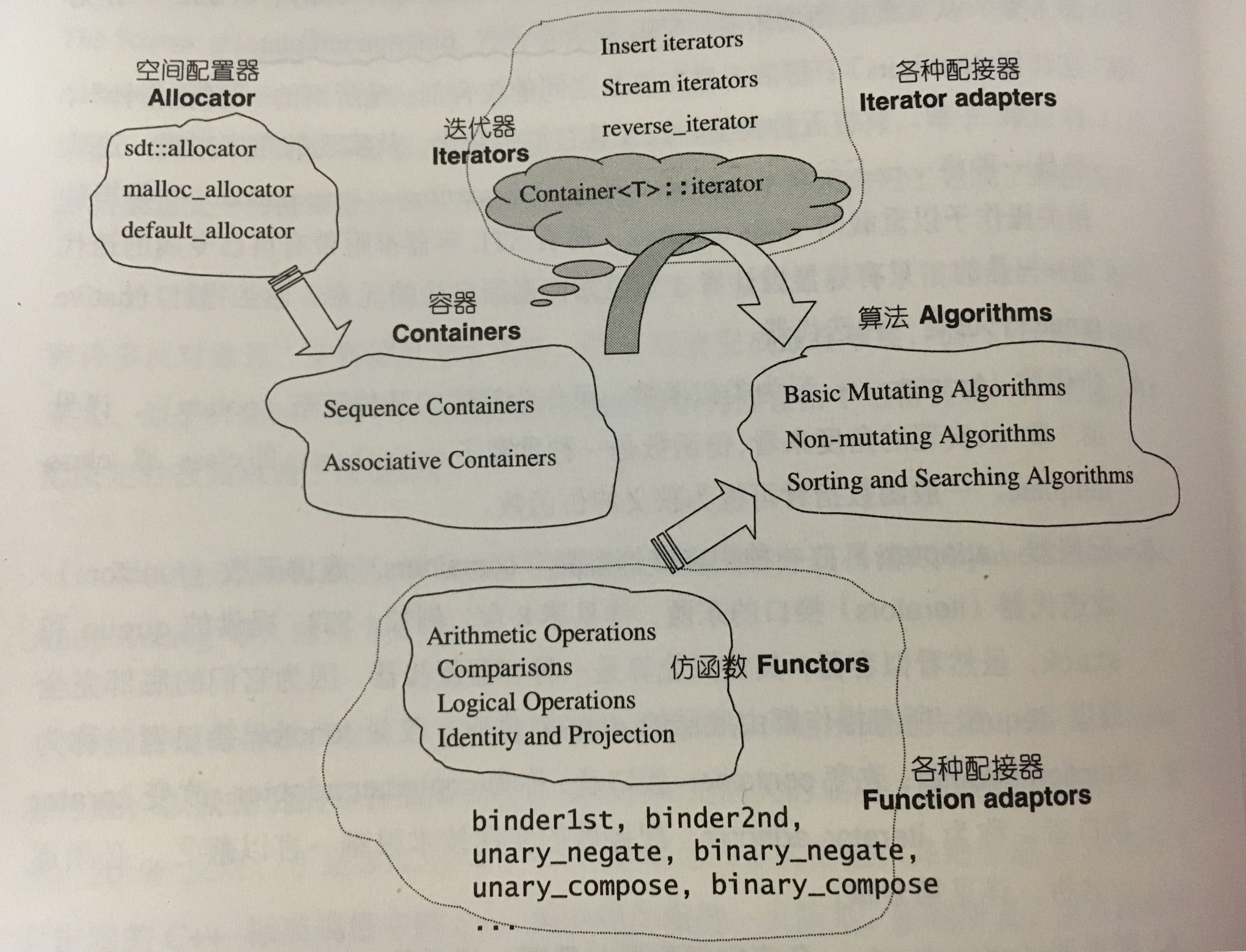
困惑的C++语法
语法1 - 临时对象的产生和运用
所谓临时对象,就是一种无名对象。它的出现如果不在程序员的预期之下,往往造成效率上的负担。但有时刻意制造一些临时对象,却又是使程序干净清爽的技巧。STL最常将此技巧应用于仿函数functor与算法的搭配上。
// overload operator()
template <typename T>
class print
{
public:
void operator()(const T& elem) {
std::cout << elem << ' ';
}
};
int a[] = {0, 1, 2, 3, 4, 5};
std::vector<int> v(a, a + 6);
for_each(v.begin(), v.end(), print<int>());// print<int>() 是一个临时对象,不是一个函数调用操作。当for_each结束时,这个临时对象也就结束了它的生命语法2 - 静态常量整数成员在class内部直接初始化
如果class内含const static integral data member,那么根据C++的标准,我们可以在class之内直接给予初值。
// in-class static constant integer initialization
template <typename T>
class testClass
{
public:
static const int _x = 1;
static const long _y = 2L;
static const char _z = 'a';
};
std::cout << testClass<int>::_x << std::endl;
std::cout << testClass<int>::_y << std::endl;
std::cout << testClass<int>::_z << std::endl;语法3 - increment/decrement/dereference 操作符
任何迭代器都必须实现increment, operator++和取值dereference, operator*的功能。前者还分为前置式prefix和后置式postfix两种,有非常规律的写法。有些迭代器具备双向移动功能,就必须再提供decrement,也分前置式和后置式两种。
class INT
{
friend std::ostream& operator<<(std::ostream& os, const INT& i);
public:
INT(int i) : m_i(i) { };
// prefix: increment and then fetch
INT& operator++()
{
++m_i; // 随着class的不同,该行应该有不同的操作
return *this;
}
// postfix: fetch and then increment
const INT operator++(int)
{
INT temp = *this;
++(*this);
return temp;
}
// prefix: decrement and then fetch
INT& operator--()
{
--(m_i); // 随着class的不同,该行应该有不同的操作
return *this;
}
// postfix: fetch and then decrement
const INT operator--(int)
{
INT temp = *this;
--(*this);
return temp;
}
// dereference
int& operator*() const
{
return (int&)m_i;// 以上转换告诉编译器,你确实要将const int转为non-const lvalue
// 如果没有转型,有些编译器会告警甚至视为错误
}
private:
int m_i;
};
std::ostream& operator<<(std::ostream& os, const INT& i)
{
os << '[' << i.m_i << ']';
return os;
}
// main.cpp
INT i_obj(5);
std::cout << i_obj++;
std::cout << ++i_obj;
std::cout << i_obj--;
std::cout << --i_obj;
std::cout << *i_obj;语法4 - 前闭后开区间表示法 [)
任何一个STL算法,都需要获得由一对迭代器(泛型指针)所标示的区间,用以表示操作范围。这一对迭代器所表示的是所谓的前闭后开区间,以[first, last)表示。也就是,整个实际范围从first开始,直到last-1。迭代器last表示:最后一个元素的下一个位置。
- 这种
off by one或者pass the end的标示法,带来了许多方便。- 前闭后开区间,元素之间无需占用连续内存空间。
template<class InputIterator, class T>
InputIterator find(InputIterator first, InputIterator last, const T& value)
{
while (first != last && *first != value) ++first;
return first;
}
template<class InputIterator, class Function>
Function for_each(InputIterator first, InputIterator last, Function f)
{
for (; first != last; ++first)
f(*first);
return f;
}语法5 - function call 操作符 operator()
函数调用操作()也可以被重载。过去C语言时代,欲将函数当做参数传递,唯有通过函数指针才能达成。
int fcmp(const void* elem1, const void* elem2)
{
const int* i1 = (const int*)elem1;
const int* i2 = (const int*)elem2;
if (* i1 < *i2) return -1;
else if (*i1 == *i2) return 0;
else if (*i1 > *i2) return 1;
}
int ia[10] = {2, 4, 1, 3, 8, 5, 4, 6, 7};
for (int i = 0; i < 10; i++)
std::cout << ia[i] << " ";
qsort(ia, sizeof(ia)/sizeof(int), sizeof(int), util::fcmp);
for (int i = 0; i < 10; i++)
std::cout << ia[i] << " ";但是,函数指针有缺点:它无法持有自己的状态,也无法达到组件技术中的可适配性(adaptability),即无法再将某些修饰条件加诸于其上而改变其状态。
为此,STL算法的特殊版本所接受的所谓条件,或策略,或一整组操作,都以仿函数形式呈现。
所谓仿函数(functor),就是使用起来像函数一样的东西,如果你针对某个class进行operator()重载,它就成为一个仿函数。至于要成为一个可配接的仿函数,还需要做一些额外的努力。
// 由于将operator()重载了,因此plus成了一个仿函数
template <class T>
struct plus
{
T operator()(const T& x, const T& y) const { return x + y; }
};
// 由于将operator()重载了,因此minus成了一个仿函数
template <class T>
struct minus
{
T operator()(const T& x, const T& y) const { return x - y; }
};
plus<int> plus_obj; // 仿函数对象
minus<int> minus_obj; // 仿函数对象
std::cout << plus_obj(1, 2) << std::endl;
std::cout << minus_obj(1, 2) << std::endl;
std::cout << plus<int>(1, 2) << std::endl;
std::cout << minus<int>(1, 2) << std::endl;上述的plus<T>和minus<T>已经非常接近STL的实现了。唯一的差别在它缺乏可配接能力。
空间配置器
- 以STL的运用角度而言,空间配置器是最不需要介绍的东西,因为它总是隐藏在一切组件(或容器)的背后,默默工作。
- 但若以STL的实现角度而言,第一个需要介绍的就是空间配置器,因为整个STL的操作对象都存放在容器之内。
- 为什么不说
allocator是内存配置器,而说是空间配置器,因为空间不一定是内存,也可以是磁盘或其他辅助存储介质。
空间配置器的标准接口
根据STL的规范,以下是allocator的必要接口:
allocator::value_type
allocator::pointer
allocator::const_pointer
allocator::reference
allocator::const_reference
allocator::size_type
allocator::difference_type
allocator::rebind
allocator::allocator() // default constructor
allocator::allocator(const allocator&) // copy constructor
template <class U>allocator::allocator(const allocator<U>&) // 泛化的copy constructor
allocator::~allocator() // destructor
pointer allocator::address(reference x) const
const_pointer allocator::address(const_reference x) const
pointer allocator::allocate(size_type n, const void* = 0)
void allocator::deallocate(pointer p, size_type n)
size_type allocator::max_size() const
void allocator::construct(pointer p, const T& x) // 等同于 new((void*) p) T(x)
void allocator::destroy(pointer p) // 等同于 p->~T()SGI特殊的空间适配器
考虑到对效率的优化,SGI默认使用特殊的空间适配器std::alloc。
一般而言,C++内存配置和释放操作是这样的:
class Foo {...};
Foo* pf = new Foo; // 配置内存,然后构造对象
delete pf; // 将对象析构,然后释放内存new算式内含两阶段操作:
- 调用
::operator new配置内存 - 调用
Foo::Foo()构造对象内容
delete算式也内含两阶段操作:
- 调用
Foo::~Foo()将对象析构 - 调用
::operator delete释放内存
STL的allocator为了精密分工,将这两个阶段操作区分开来:
- 内存配置操作由
alloc::allocate()负责 - 内存释放操作由
alloc::deallocate()负责 - 对象构造操作由
::construct()负责 - 对象析构操作由
::destroy()负责
考虑到小型区块所可能造成的内存碎片问题,SGI容器使用了两级空间适配器的设计。
- 第一级配置器直接使用
malloc()和free() - 第二级配置器则视情况采取不同的策略
- 当配置区块超过128B时,视之为“足够大”,便调用第一级配置器
- 当配置区块小于128B时,视之为“过小”,为了降低额外负担,便采用复杂的
memory pool整理方式,而不再求助于第一级配置器。

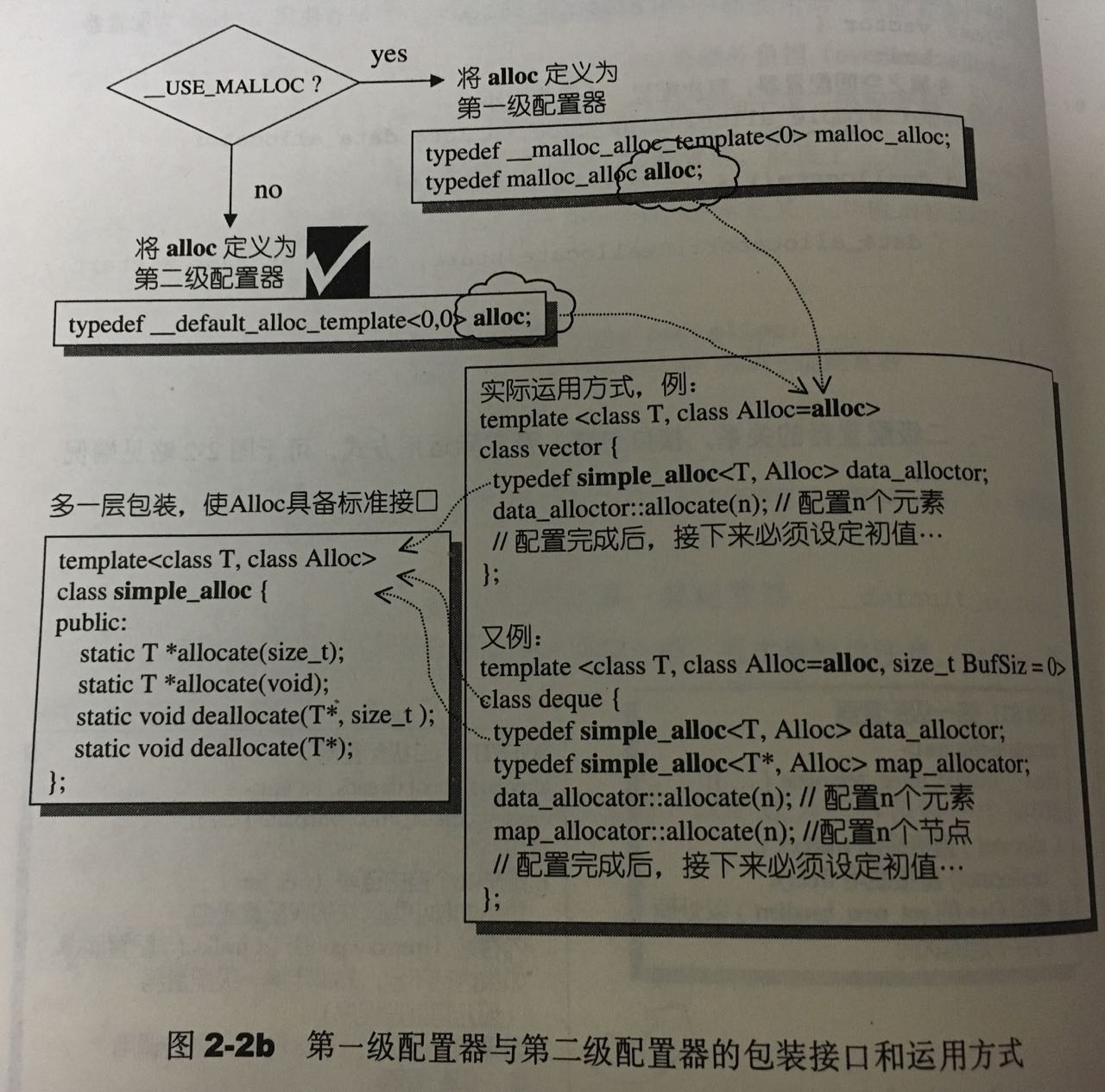
第二级配置器设计原理
- 第二级配置器多了一些机制,避免太多小额区块造成内存的碎片。
- 小额区块带来的其实不仅是内存碎片,配置时的额外负担(overhead)也是一个大问题。区块越小,额外负担所占的比例就越大,越显得浪费。
- SGI第二级配置器的做法是,如果区块大于128B,就交给第一级配置器处理;如果区块小于128B,就以内存池管理。每次配置一块大内存,并维护对应的自由链表,下次若再有相同大小的内存需求,就直接从自由链表中拔出;如果客户端释放了小额区块,就由配置器回收到自由链表中。即,配置器负责配置和回收。
- 为了方便管理,第二级配置器会主动将任何小额区块的内存需求量上调至8的倍数,并维护16个自由链表,各自管理大小分别为8,16,24,32,40,48,56,64,72,80,88,96,104,112,120,128字节的小额区块。
自由链表的结构如下:
使用union结构,是一种节省空间的方法(一物二用)。
- 联合是可以(在不同时刻)保存不同类型和长度的对象的变量,编译器负责跟踪对象的长度和对齐要求。
- 实际上,联合就是一个结构,它的所有成员相对于基地址的偏移量都为0,此结构空间要大到足够容纳最“宽”的成员,并且,其对齐方式要适合于联合中所有类型的成员。
- 联合只能用其第一个成员类型的值进行初始化。
union obj {
union obj * free_list_link;
char client_data[1]; // the client sees this
};第二级配置器的部分实现
enum {
__ALIGN = 8 // 小型区块的上调边界
};
enum {
__MAX_BYTES = 128 // 小型区块的上限
};
enum {
__NFREELISTS = __MAX_BYTES / __ALIGN // free_lists个数
};
template <bool threads, int inst>
class __default_alloc_template {
private:
// 将bytes上调至8的倍数
static size_t ROUND_UP(size_t bytes) {
return ( (bytes + __ALIGN - 1) & ~(__ALIGN - 1));
}
union obj {
union obj * free_list_link;
char client_data[1]; // the client sees this
};
static obj * volatile free_list[__NFREELISTS];
static size_t FREELIST_INDEX(size_t bytes) {
return ( (bytes + __ALIGN - 1) / __ALIGN - 1 );
}
// 返回一个大小为n的对象,并可能加入大小为n的其他区块到free_list
static void *refill(size_t n);
// 配置一大块空间,可容纳nobjs个大小为size的区块
// 如果配置nobjs个区块有所不便,nobjs可能会降低
static char *chunk_alloc(size_t size, int &nobjs);
// chunk allocation state
static char *start_free; // 内存池的起始位置,只在chunk_alloc中变化
static char *end_free; // 内存池的结束位置,只在chunk_alloc中变化
static size_t heap_size;
public:
static void *allocate(size_t n);
static void deallocate(void *p, size_t n);
static void *reallocate(void *p, size_t old_sz, size_t new_sz);
};
// 以下是static data member的定义与初始值设定
template <bool threads, int inst>
char *__default_alloc_template<threads, inst>::start_free = 0;
template <bool threads, int inst>
char *__default_alloc_template<threads, inst>::end_free = 0;
template <bool threads, int inst>
size_t __default_alloc_template<threads, inst>::heap_size = 0;
template <bool threads, int inst>
__default_alloc_template<threads, inst>::obj * volatile
__default_alloc_template<threads, inst>::free_list[__NFREELISTS] = {0, 0, 0, 0, 0, 0, 0, 0, 0, 0, 0, 0, 0, 0, 0, 0}; // 16个自由链表空间配置函数的实现 - allocate
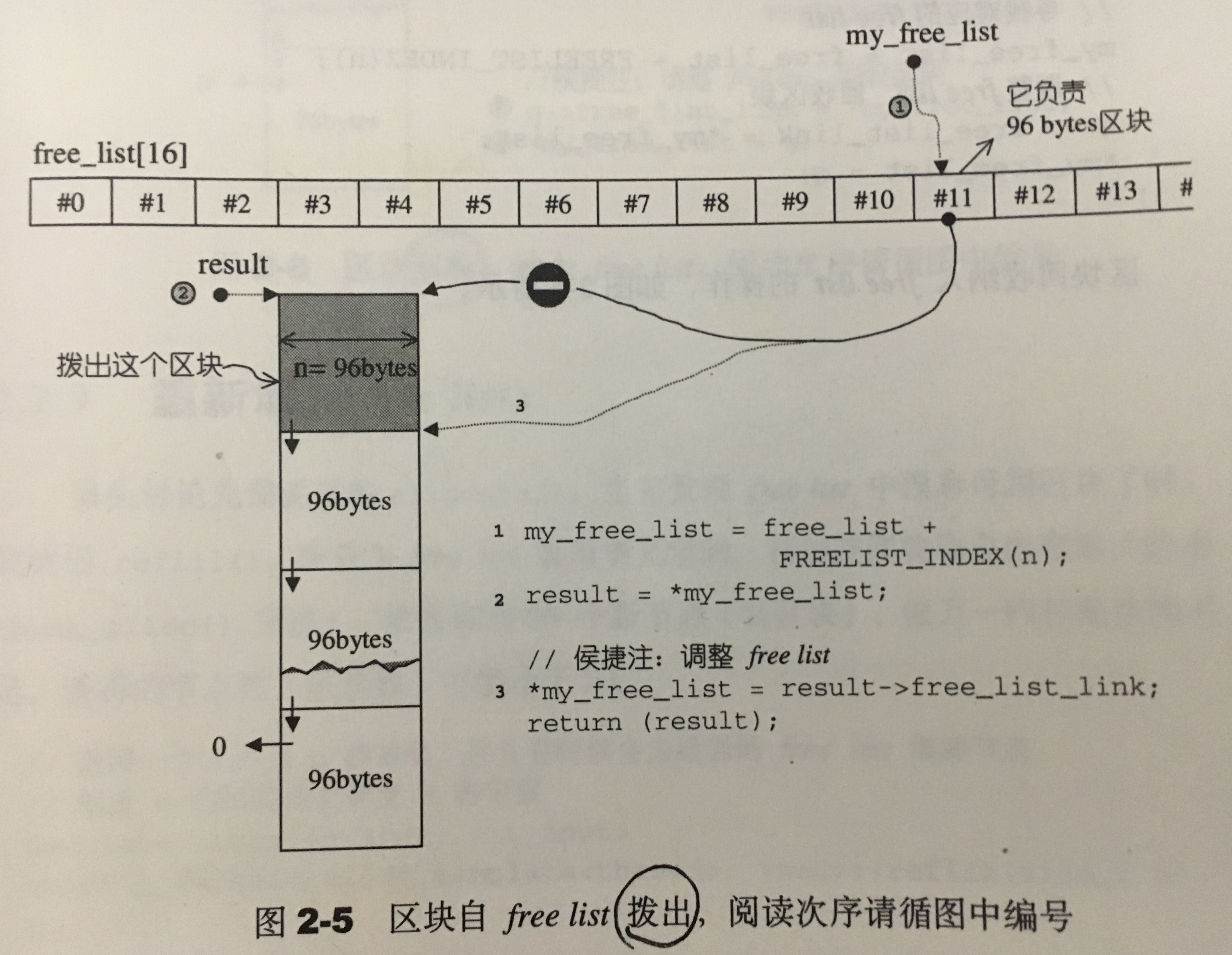
static void * allocate(size_t n)
{
obj * volatile * my_free_list;
obj * result;
// 大于128B就调用第一级配置器
if (n > (size_t) __MAX_BYTES) {
return (malloc_alloc::allocate(n));
}
// 寻找16个free_lists中适当的一个
my_free_list = free_list + FREELIST_INDEX(n);
result = *my_free_list;
if (result == 0) {
// 没有找到可用的free_list,准备重新填充free_list
void *r = refill(ROUND_UP(n));
return r;
}
// 调整free_list,拔出这个区块
*my_free_list = result->free_list_link;
return result;
}
template <bool threads, int inst>
void * __default_alloc_template<threads, inst>::refill(size_t n)
{
int nobjs = 20;
// 调用chunk_alloc(),尝试取得nobjs个区块作为free list的新节点
char * chunk = chunk_alloc(n, nobjs);
obj * voliatile * my_free_list;
obj * result;
obj * current_obj, * next_obj;
int i;
// 如果只获得一个区块,这个区块就分配给调用者用,free list无新节点
if (1 == nobjs) return chunk;
// 否则准备调整free list,纳入新节点
my_free_list = free_list + FREELIST_INDEX(n);
// 以下在chunk空间内建立free list
result = (obj *)chunk;// 这一块返回给调用者
// 以下引导free list指向新配置的空间
*my_free_list = next_obj = (obj*)(chunk + n);
// 以下将free list的各节点串接起来
for (i = 1; ; i++) {
current_obj = next_obj;
next_obj = (obj *)((char *)next_obj + n);
if (nobjs - 1 == i) {
current_obj -> free_list_link = 0;
break;
} else {
current_obj->free_list_link = next_obj;
}
}
return result;
}空间释放函数的实现 - deallocate
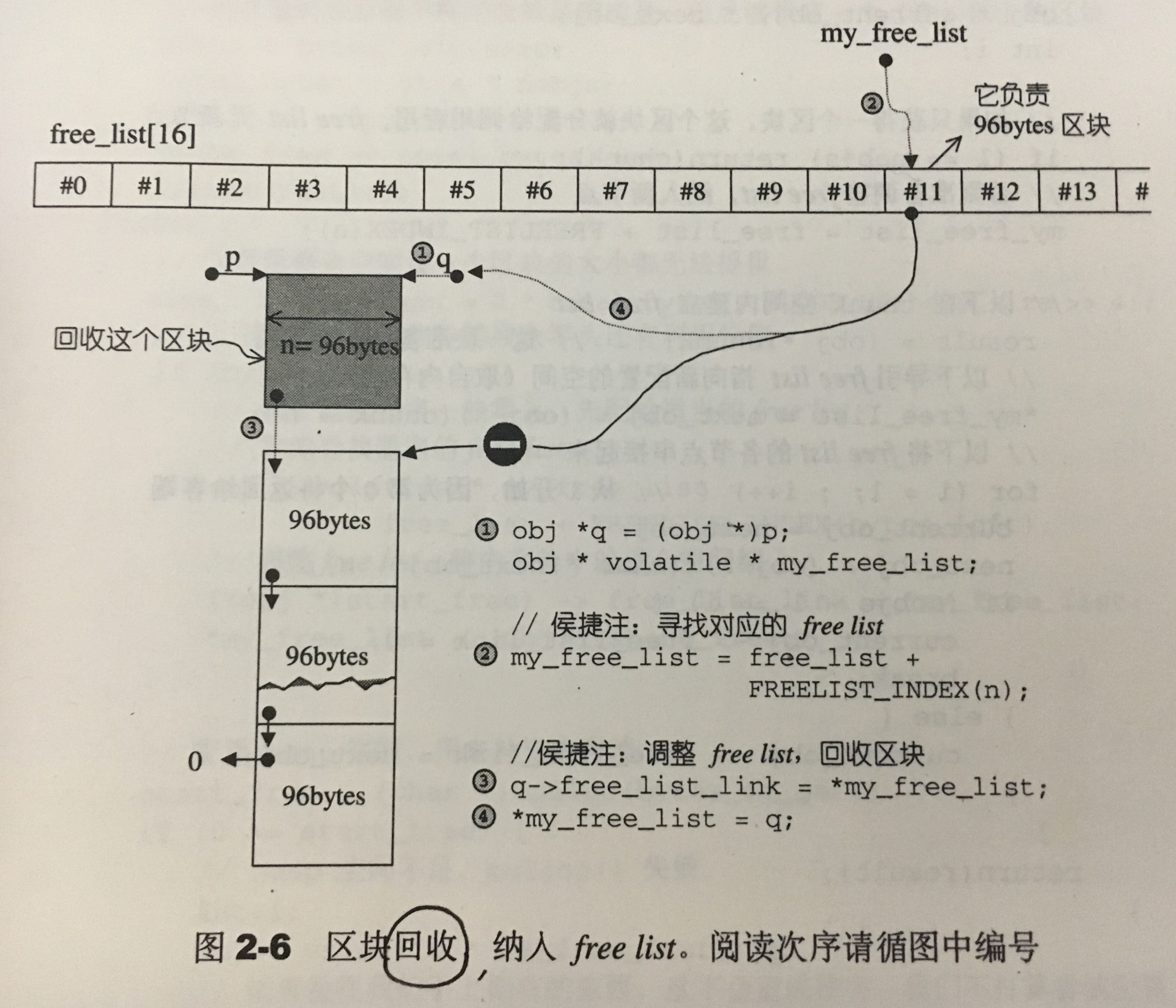
static void deallocate(void *p, size_t n)
{
obj * q = (obj *)p;
obj * volatile * my_free_list;
// 大于128B就调用第一级配置器
if (n > (size_t) __MAX_BYTES) {
malloc_alloc::deallocate(p, n);
return;
}
// 寻找对应的free_list
my_free_list = free_list + FREELIST_INDEX(n);
// 调整free_list,回收这个区块
q->free_list_link = *my_free_list;
*my_free_list = q;
}内存池 (memory pool)
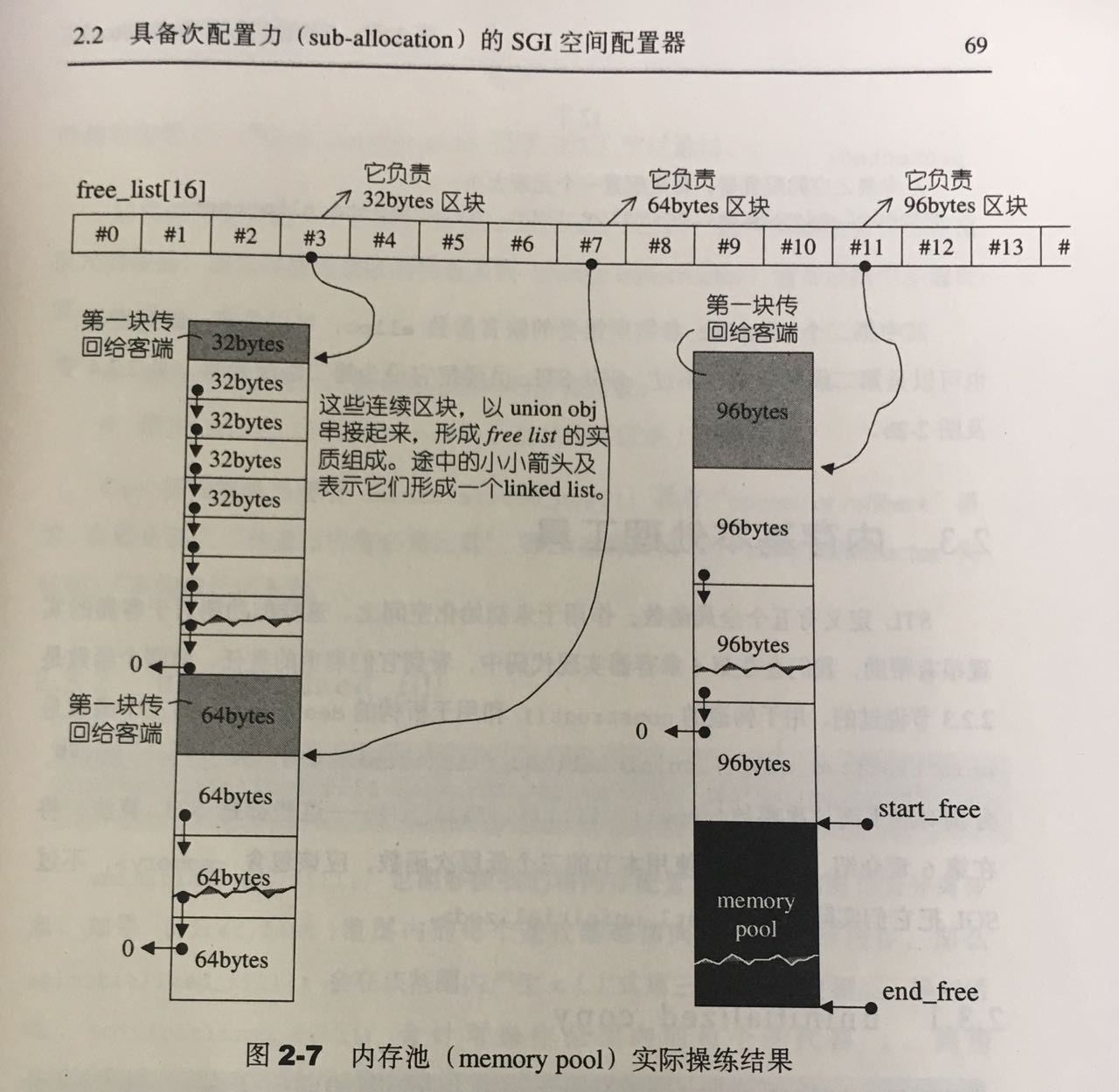
template <bool threads, int inst>
char * __default_alloc_template<threads, inst>::chunk_alloc(size_t size, int& nobjs)
{
char * result;
size_t total_bytes = size * nobjs;
size_t bytes_left = end_free - start_free;// 内存池剩余空间
if (bytes_left >= total_bytes) {
// 内存池剩余空间完全满足需求量
result = start_free;
start_free += total_bytes;
return result;
} else if (bytes_left >= size) {
// 内存池剩余空间不能完全满足需求量,但足够供应一个(含)以上的区块
nobjs = bytes_left / size;
total_bytes = size * nobjs;
result = start_free;
start_free += total_bytes;
return result;
} else {
// 内存池剩余空间连一个区块的大小都无法提供
size_t bytes_to_get = 2 * total_bytes + ROUND_UP(heap_size >> 4);
// 以下试着让内存池中残余零头还有利用价值
if (bytes_left > 0) {
// 内存池还有一些零头,先配给适当的free list
// 首先寻找适当的free list
obj * volatile * my_free_list = free_list + FREELIST_INDEX(bytes_left);
// 调整free list,将内存池中的残余空间编入
((obj *)start_free) -> free_list_link = *my_free_list;
*my_free_list = (obj *)start_free;
}
// 配置heap空间,用来补充内存池
start_free = (char *)malloc(bytes_to_get);
if (0 == start_free) {
// heap空间不足,malloc失败
int i;
obj * volatile * my_free_list, * p;
for (i = size; i <= __MAX_BYTES; i += __ALIGN) {
my_free_list = free_list + FREELIST_INDEX(i);
p = *my_free_list;
// free list尚有未用区块
if (0 != p) {
// 调整free list以释放出未用区块
*my_free_list = p -> free_list_link;
start_free = (char *)p;
end_free = start_free + i;
// 递归调用自己,为了修正nobjs
return (chunk_alloc(size, nobjs));
}
}
end_free = 0;// 如果出现意外,山穷水尽,到处都没有内存可用了
// 调用一级适配器,看看out-of-memory机制能否尽点力
start_free = (char *)malloc_alloc::allocate(bytes_to_get);
// 这会导致抛出异常,或内存不足的情况获得改善
}
heap_size += bytes_to_get;
end_free = start_free + bytes_to_get;
// 递归调用自己,为了修正nobjs
return (chunk_alloc(size, nobjs));
}
}C++ named requirements: Compare
Compare is a set of requirements expected by some of the standard library facilities from the user-provided function object types.
The return value of the function call operation applied to an object of a type satisfying Compare, when contextually converted to bool, yields true if the first argument of the call appears before the second in the strict weak ordering relation induced by this type, and false otherwise.
The following expressions must be valid and have their specified effects:
| Expression | Requirements |
|---|---|
comp(a, b) |
Establishes strict weak ordering relation with the following properties |
For all a, comp(a, a) == false |
|
If comp(a, b) == true then comp(b, a) == false |
|
if comp(a, b) == true and comp(b, c) == true then comp(a, c) == true |
Refer
- The Annotated STL Sources(using SGI STL) by 侯捷